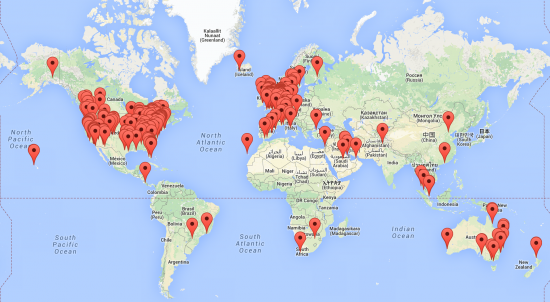Cultural differences in websites

At Yoast, we look at sites from all over the world. Websites from different countries can differ greatly in their choices for color, pictures, navigation and site structure. That made me wonder: are these differences due to cultural preferences? It made me remember a study we executed at Yoast some time ago and it gave me an excuse to do some digging in the scientific search engines as well.

Why are cultural differences important?
As the web is growing and online shops are aiming at international markets, cultural differences and preferences in web design become of importance. Is a web page designed in one country equally appealing to potential customers in other countries? Are these international customers more likely to buy your stuff, if the design of your shop resembles the style of websites in their home country?
It could well be that the Yoast.com design appeals to a western audience, who perceive our avatars as funny or creative, while in China or Japan is our design is considered as childish and unappealing. In that case, we could alter our design in order to do big business in the far east…
Results from our own research
In 2012, we did some research comparing websites from the United States with websites from the Netherlands. We executed this research to inspire us to design our own themes. We decided to limit our focus on websites of dentists in both the United States and the Netherlands.
The most prominent result of our research was the use of pictures. In the United States, it was common for a website to have a so-called ‘smile gallery’ with a number of pictures displaying beautiful white teeth from satisfied customers. In the Netherlands (bleaching of teeth is not common at all, in fact we all have yellow teeth here ;-) ) such galleries do not exist. This cultural difference is only applicable to dentist websites. You could imagine though that this kind of cultural differences could appear in other industries as well.
Differences in content and navigational elements
Our research also shows differences in actual design and navigational elements. In table 1 we show the presence of some content and navigational elements on dentist websites. We display percentages of sites in which an element was present. We compare between sites of dentists from the US and sites of dentists from the Netherlands.
| USA | Netherlands | |
|---|---|---|
| Testimonials | 50,0 | 25,7 |
| Social Media | 41,5 | 25,7 |
| FAQ | 32,1 | 35,0 |
| Opening hours | 67,9 | 79,9 |
| Search function | 13,2 | 24,8 |
| Footer Bar | 65,1 | 48,1 |
| Headings | 79,2 | 79,5 |
| Slide show | 25,5 | 17,6 |
| Movie | 15,1 | 6,5 |
| Number of websites | 106 | 433 |
Results from our research show that American sites display testimonials more often and use social media on their website in more cases. On Dutch sites opening hours are shown more often and the search function of the website is present in more cases. American sites more often have slide shows and movies on their website. Headings are used equally in both countries, but a footer bar is often absent in Dutch website. These differences in websites could well be due to differences between dentist and dental insurance between the US and the Netherlands.
Color is subjective, of course. But judging from all websites we have analyzed, it’s safe to say that blue and blueish green, combined with a white background, are commonly used for both American and Dutch websites. The main difference lies in the mood set on the website. Where Dutch websites have a more business-like approach, American websites focus more on location or pictures of happy, smiling people.
From a scientific perspective
A quick search in some scientific search engines (Google Scholar, Picarta) soon gave me a pretty good idea of the scientific view on this subject. Many studies try to explain cultural preferences in web design, content and navigation with the model of Hofstede (e.g. Callahan, 2006).
In Hofstede’s model of Culture five dimensions are distinguished, the world cultures vary along these five dimensions (all very interesting, but a bit out of scope for this post, though). Studies using Hofstede’s model, for instance, show that in more individualistic countries (US, Australia) websites show more pictures of individuals, while in collective societies (e.g. China) more images of groups are shown. Websites from the United States also appear much more personalized compared to websites from Korea or China (Zhao, Massey, Murphy and Fang, 2003). Studies also suggest differences in the preferences of navigational buttons (with or without text) and site structure (Lo & Gong, 2005).
Cultural differences in shopping behavior also appear persistent, even within the borders of Europe. Research shows that norms, values differ greatly between countries within Europe. Moreover, cultural differences are persistent between countries in Europe and between Europe, the United States, Japan and China (Mooij & Hofstede, 2002; 2011). This research also shows large differences in shopping preferences. Mooij en Hofstede state that ‘expanding operations to countries with different cultural values than one’s own, without adapting to these differences can lead to serious losses.’
Do some market research!
Interesting? But what does this have to do with your website? Well, if you have a online shop and you want to expand your market, chances are that one country may be more prone to buy your product than another country. While organic fabrics may sell perfectly well in Scandinavian countries, the same product will probably not be that successful in southern European countries. This will be due to differences in preferences, norms, values and prosperity between the countries. So it would be very wise to begin with some market research before taking your online shop abroad!
In our case, before expanding our market and translating the texts on our website in Japanese, I should try to find out whether or not people in Japan are awaiting our plugins and site reviews. Is there any market in Japan for our products? As our Yoast SEO is already largely translated in Japanese AND we have already done some sales, Japan could very well be a market for Yoast to grow in!
Alter your design
So, differences between cultures in design preferences as well as in shopping preferences are obvious. But do different cultures react differently to the design of your website? Will Germans buy your American cookies if the design of your American website isn’t altered? I tried hard, but I could not find systematic research that precisely answers this question (would love to do that myself someday ;-)). I did, however, find some evidence that the promotional tactics (convincing people to buy your product) show little cultural differences (Kwok and Uncles, 2005).
Kwok and Uncles find ‘that despite the existence of cultural differences at an ethnic level, culture does not appear to have a significant impact on consumer responses to sales promotion’. This means that although there appear to be differences between cultures, these differences do not lead to a different reaction of people on promotional activities. Different cultures thus respond similar to changes in prices and marketeers do not have to alter their strategies in order to promote their products to different cultural groups. One could argue that a website is also some kind of product promotion. I would probably argue it is a little bit more than that. However, we should not immediately assume that different strategies are needed in order to sell our products.
Your biological fabrics will not sell in some countries, not because the design of your website is not appealing to a culture, but because your product just isn’t that appealing in that culture. Changing the design of your website favoring the preferences of a new cultural target group will only work if the cultural target group actually is interested in your product. And even then…
What am I to do with this information?
If you are focusing on a local market: make sure your website appeals to a local public. That would be enough. Merely living in your local market would already give you enough expertise to investigate whether your website is, in fact, appealing to your audience. If you are unsure: ask your audience!
If you are aiming at an international public, as we do at Yoast, it could be wise to consider some revisions to your website in order to make it more appealing to an international market. The results of our own research and the scientific literature imply the existence of cultural differences between websites. It thus could be profitable to translate your content to different languages and offer different pictures of navigational options according to culture. Translating our plugins pages to Japanese and altering our avatars to Manga-style could perhaps be a great next step for Yoast (and a nice challenge for Erwin ;-).
If you want to expand your horizon and start selling your products in different countries, you should focus on those countries in which there is a demand for your product. Good market research is an absolute necessity! Large changes in the design of your website would not be my first priority. That does not mean that you do not have to alter a single thing! Making sure you use the language of your target group is important (this post in Dutch would not have such a large audience). Offering the products in the currency of your target country will help as well. Finally, make sure the website looks trustworthy and apply for the warranties of the countries you are selling your products in!
Read more: What is UX – and why bother? »


Spot on with the cultural differences and that our western ideas of clean can mean childish in for example China.
Perhaps a nice example is of these two Chinese websites.
The first one is Sina, which is one of the biggest portal websites. Chinese people just love to read everything new in this way. For us westerners, apart from the fact that the characters already make it look messy in our eyes – the sheer size and eternal scrolling down, just doesn’t make for a great experience: http://www.sina.com.cn/
Then Taobao which is probably the largest ecommerce site on a global scale. They have actually already implemented different sites for different users. The global site is http://www.taobao.com/market/global/index_new.php, whereas when you are browsing on a Chinese IP address the site you get served is much more shocking (again from a western perspective); screenshot on Evernote: https://www.evernote.com/shard/s19/sh/e38a56d8-45b5-4b8a-9d78-7d314bc72ba1/35aba23d8934a3018443213f9c0b39ce/deep/0/taobao-chinese-version.png
thanks for your feedback, I am going to look into this!
Sure no worries. And if you find anything that you would like to see from a Chinese IP address, just let me know and I’ll see what I can do for you.
Very interesting research. I would say that US website like to show white teeth, whether they sell dental services or not.
It certainly is difficult to make a “one size fit all” website. If you are to go with a single website and a global audience, you have to find the common denominators. Otherwise, if you can afford it, and if it’s worth the efforts, go a with a version for each locale. Easier said than done…I know.
This is very insightful – thanks! We have clients for our travel companies in Nepal who come from all over the world, but they find us online first. We are currently re-designing our web sites, so this post has perfect timing for us!
Marieke It really an Amazing Research, I never thought about it before….
Thanks.
Its an interesting case study and I never thought about this ..not me many of us never thought these angles while developing sites and targetting any geo location.
Thanks for sharing.